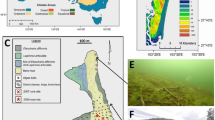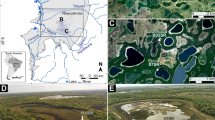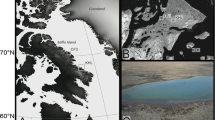Abstract
This pilot study examines the potential of obtaining a sedimentary record of paleoenvironmental/climatic/hydrologic conditions for saline Redberry Lake in southern Saskatchewan, Canada. The tools are mineralogy, stable isotopes and pigments. The upper meter of an offshore sediment core contains 10 to 20% by weight aragonite (CaCO3), which apparently precipitated in the water column. The δ18O and δ13C of the bulk aragonite (corrected for content of detrital calcite) vary by 4 to 5‰. Enrichment in 18O in aragonite is significantly correlated with pigment concentrations (chlorophyll a, phaeophytin). The δ18O and pigment data provide evidence for relatively dry and/or warm conditions and high limnetic productivity for the period 2500 to 1500 yrs B.P. After 1500 B.P., the climate was apparently similar to the present, with two episodes of relatively enhanced productivity, dryness and/or warmth, at around 1000 to 900 and 500 to 200 B.P. During the past century, Redberry Lake has decreased approximately 8 m in depth and its salinity has doubled. No clear sedimentary signal was observed in response to these recent hydrologic trends. These changes have not been associated with a significant climate trend in the region, but may have been induced by land use changes in the catchment.
Similar content being viewed by others
References
Al-Aasm, I. S., 1990. Stable isotope analysis of multiple carbonate samples using selective acid extraction. Chem. Geol. (Isot. Geosc. Sect.) 80: 119–125.
Beak Associates Consulting Ltd., 1989. Redberry Lake Management Planning Program, Background Report. Saskatoon, Canada.
Bryson, R. A. & W. M. Wendland, 1967. Tentative climatic patterns for some late glacial and post-glacial episodes in central North America. Univ. Wisconsin Dept. Meterology, Tech. Rept. no. 34, p. 271–298.
Callender, E., 1968. The postglacial sedimentology of Devil's Lake, North Dakota. PhD Thesis, U. of North Dakota, Grand Forks, N.D. 312 pp.
Edwards, T. W. D. & P. Fritz, 1988. Stable isotope paleoclimate records for southern Ontario, Canada: comparison of results from marl and wood. Can. J. Earth Sci 25: 1397–1406.
Edwards, T. W. D. & J. H. McAndrews, 1989. Paleohydrology of a Canadian Shield lake inferred from 18O in sediment cellulose. Can. J. Earth Sci. 26: 1850–1859.
Fritz, P., T. W. Anderson & C. F. M. Lewis, 1975. Late Quaternary climatic trends in history of Lake Erie from stable isotope studies. Science 190: 267–269.
Fritz, S. C., S. Juggins, R. W. Battarbee & D. R. Engstrom, 1991. Reconstruction of past changes in salinity and climate using a diatom-based transfer function. Nature 352: 706–708.
Gonfiantini, R., 1986. Environmental isotopes in lake studies. In P. Fritz & J. Ch. Fontes (eds), Handbook of Environmental Isotope Geochemistry, Vol. 2: 113–168.
Grossman, E. T. & T. L. Ku, 1981. Aragonite-water isotopic paleotemperature scale based on the benthic foraminifera Hoeglundia elegans. Geol. Soc. Am. Abstr. with Program 13: 464.
Hammer, U. T., 1990. The effect of climate change on the salinity, water levels and biota of Canadian prairie saline lakes. Verh. int. Ver. Limnol. 24: 321–326.
Hammer, U. T. & R. C. Haynes, 1978. The saline lakes of Saskatchewan. II. Locale, hydrography and other physical aspects. Int. Revue ges. Hydrobiol. 63: 179–203.
Herczeg, A. L. & R. G. Fairbanks, 1987. Anamalous carbon isotope fractionation between atmospheric CO2 and dissolved inorganic carbon induced by intense photosynthesis. Geochim. cosmochim. Acta 51: 895–899.
Hickman, M. & D. M. Klarer, 1981. Paleolimnology of Lake Isle, Alberta, Canada (including sediment chemistry, pigments and diatom stratigraphy). Arch. Hydrobiol. 91: 490–508.
Hodell, D. A., J. H. Curtis, G. A. Jones, A. Higuera-Gundy, M. Brenner, M. W. Binford & K. T. Dorsey, 1991. Reconstruction of Caribbean climate change over the past 10 500 years. Nature 352: 790–793.
Killey, R. W. D. & P. Fritz, 1979. Carbon dioxide flux across a lake-atmosphere interface as determined by carbon isotope data. In Isotopes in Lake Studies, International Atomic Energy Agency, Vienna, p. 245–249.
Last, W. M., 1980. Sedimentology and postglacial history of Lake Manitoba. PhD Thesis, University of Manitoba, 689 pp.
Last, W. M., 1990. Paleochemistry and paleohydrology of Ceylon Lake, a salt-dominated playa basin in the northern Great Plains, Canada. J. Paleolim. 4: 219–238.
Last, W. M. & L. A. Slezak, 1986. Paleohydrology, sedimentology and geochemistry of two meromictic saline lakes in southern Saskatchewan. Géographie physique et Quaternaire XL: 5–15.
Lichti-Federovich, S., 1970. The pollen stratigraphy of a dated section of Late Pleistocene lake sediment from central Alberta. Can. J. Earth Sci. 7: 938–945.
Marquart, R. G., 1986. uPDSM: Mainframe search/math, on an IBM PC. Powder Diffract. 1: 34–36.
Mott, J. R. & E. A. Christiansen, 1981. Palynological study of slough sediments from central Saskatchewan. In Geol. Survey Can., Ottawa, Current Research, Part B, paper 81-1B: 133–136.
Mott, R. J., 1973. Palynological studies in central Saskatchewan, pollen stratigraphy from lake sediment sequences. Geol. Survey Can., Ottawa, Paper 72–49: 18 pp.
Nalepa, T. F. & M. A. Quigley, 1987. Distribution of photosynthetic pigments in nearshore sediments of Lake Michigan. J. Great Lakes Res. 13: 37–42.
Radle, N., C. M. Keister & R. W. Battarbee, 1989. Diatom, pollen and geochemical evidence for the paleosalinity of Medicine Lake, S. Dakota,during the Late Wisconsin and early Holocene. J. Paleolim. 2: 159–172.
Robarts, R. D., M. S. Evans & M. T. Arts, 1992. Light, nutrient and water temperature as determinants of phytoplankton production in two saline, prairie lakes with high sulphate concentrations. Can. J. Fish. aquat. Sci. 49: 2281–2290 (in press).
Romanek, C. S., E. L. Grossman & J. W. Morse, 1992. Carbon isotopic fractionation in synthetic aragonite and calcite: Effects of temperature and precipitation rate. Geochim. cosmochim. Acta 56: 419–430.
Rubinson, M. & R. N. Clayton, 1969. Carbon-13 fractionation between aragonite and calcite. Geochim. cosmochim. Acta 33: 997–1002.
Sauchyn, D. J., 1990. A reconstruction of Holocene geomorphology and climate, western Cypress Hills, Alberta and Saskatchewan. Can. J. Earth Sci. 27: 1504–1510.
Schultz, L. G., 1964. Quantitative interpretation of mineralogical composition from X-ray and chemical data for the Pierre Shale. U. S. Geol. Survey, Prof. Paper 391-C, 31 pp.
Strickland, J. D. H. & T. R. Parsons, 1972. A Practical Handbook of Seawater Analysis. Fisheries Research Board of Canada, Bulletin 167.
Talbot, M. R., 1990. A review of the palaeohydrological interpretation of carbon and oxygen isotopic ratios in primary lacustrine carbonates. Chem. Geol. (Isotope Geosci. Sect.) 80: 261–279.
Tarutani, T., R. N. Clayton & T. K. Mayeda, 1969. The effect of polymorphism and magnesium substitution on oxygen isotope fractionation between calcium carbonate and water. Geochim. cosmochim. Acta 33: 987–996.
Turner, J. V., P. Fritz, P. F. Karrow & B. G. Warner, 1983. Isotopic and geochemical composition of marl lake waters and implications for radiocarbon dating of marl lake sediments. Can. J. Earth Sci. 20: 599–615.
Vance, R. E., D. Emerson & T. Habgood, 1983. A mid-Holocene record of vegetative change in central Alberta. Can. J. Earth Sci. 20: 364–376.
Water Survey of Canada, 1989. Historical streamflow summary, Saskatchewan, to 1988. Inland Waters Directorate, Environment Canada, 421 pp.
Wollast, R., D. Debouverie & P. H. Duvigneaud, 1971. Influence of Sr and Mg on the stability of calcite and aragonite. In O. P. Bricker (ed), Carbonate Cements, Johns Hopkins Press, Baltimore, Md.: 274–277.
Author information
Authors and Affiliations
Rights and permissions
About this article
Cite this article
Van Stempvoort, D.R., Edwards, T.W.D., Evans, M.S. et al. Paleohydrology and paleoclimate records in a saline prairie lake core: mineral, isotope and organic indicators. J Paleolimnol 8, 135–147 (1993). https://doi.org/10.1007/BF00119786
Received:
Issue Date:
DOI: https://doi.org/10.1007/BF00119786




